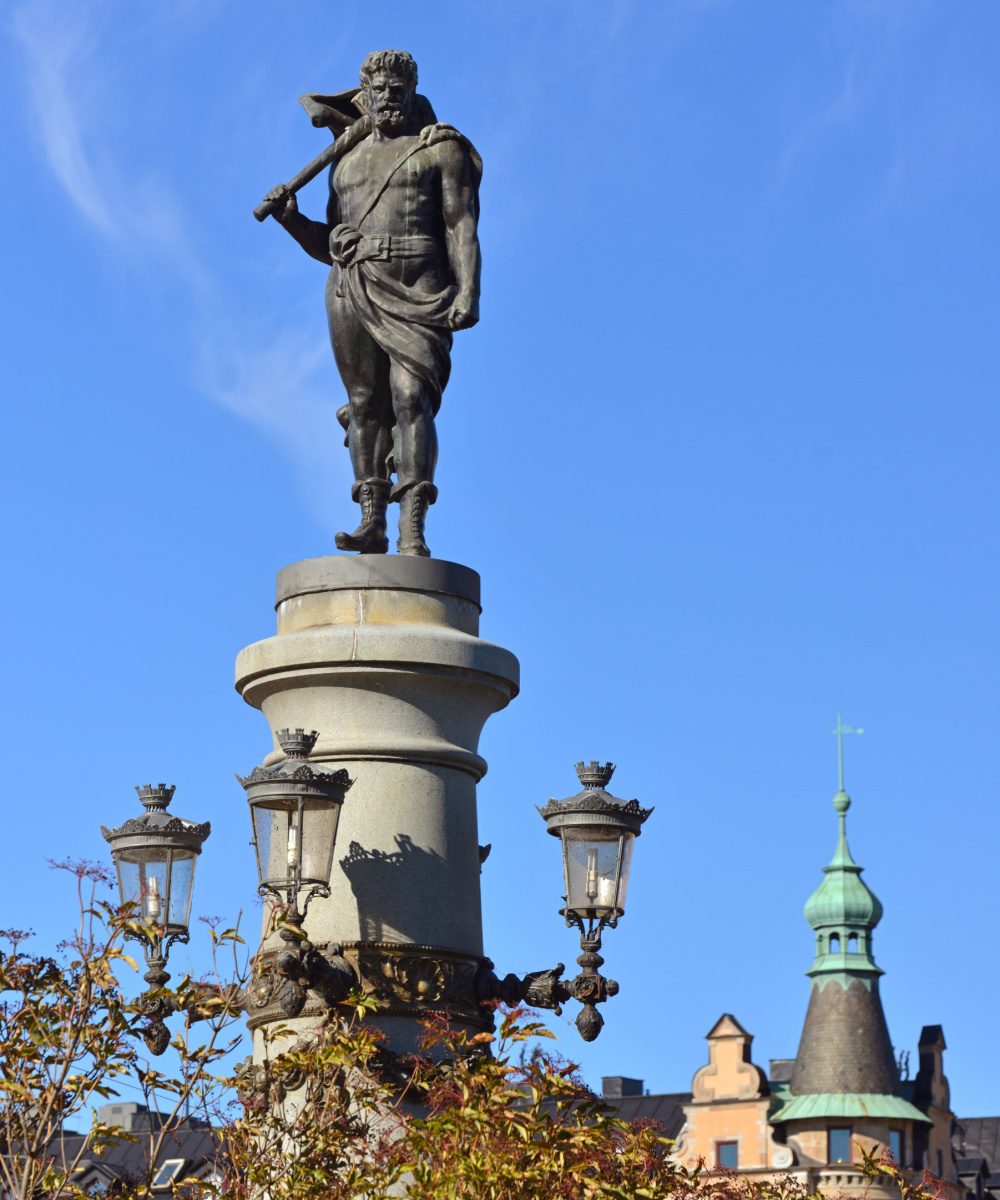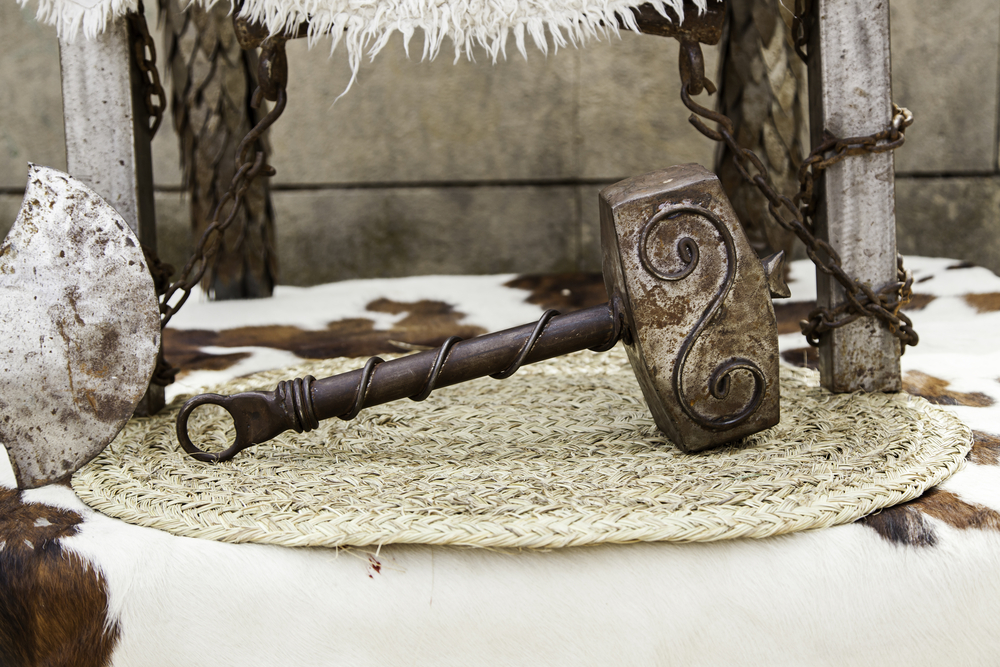Thor truly lives up to his billing as the thunder god, bringing the storm wherever he goes in Norse mythology! The son of Odin has a larger-than-life presence across the Norse pantheon and has captivated minds for centuries. However, Thor is far more complex than his depiction as a hammer-wielding warrior would suggest. Within his mythic exploits lie intriguing contradictions and mysteries.
How much do you really know about this beloved yet enigmatic deity?

Table of Contents
Who Was Thor?
Thor was a prominent Norse deity and was known as the god of thunder, strength, and protection. He occupied a central role in the Norse pantheon and was revered by both gods and humans alike. As the son of Odin, the chief god, and Fjörgyn, the earth goddess, Thor held immense power and significance. He was married to the golden-haired goddess Sif and had a number of children, including his daughter, Thrúd, and the sons Modi and Magni.
What Does Thor Mean?
The name Thor is derived from the Old Norse word "Þórr," which means "thunder" or “thunderer”. This Old Norse name derives from the Proto-Germanic “Þunraz”, meaning “thunder”. In various Germanic languages and cultures, the name Thor also had other variations. For example, in Old English, it was "Þunor" or "Þūr"; in Old High German, it was "Donar"; and in Modern German it is "Donar" or "Donner". Some linguists have linked Thor to Proto-Germanic and Old Norse words meaning “to roar” or “to make noise”. The Old Norse “Þórr” may also be connected to the name of the rune ᚦ Thurs (Thursday is literally Thor’s Day), which was used to represent the 'th' sound and was tied to Thor due to its association with thunder. Thor may be linguistically related to deities in other Indo-European pantheons with similar attributes, like the Celtic Taranis and Hittite Teshub, hinting at an ancient Proto-Indo-European root word.
What Does Thor Look Like?
Thor was often depicted as a formidable figure, possessing incredible physical strength and wielding the mighty hammer called Mjölnir. This enchanted hammer not only symbolised his authority over thunder and lightning but served as a tool of protection against the forces of chaos and the giants. His ear-splitting hammer strikes were believed to create thunderstorms. He was also described as being strong and muscular with piercing eyes that “flash like lightning” and often wore armour made of iron or silver. This armour included his mystical Megingjörð belt, which doubled his already considerable strength!
Want to put your knowledge of the Norse pantheon to the test?
Centre of Excellence has you covered.
Visit our Norse Gods and Goddesses Hub to sample the first 2 modules of our £127 Norse Mythology Diploma Course for FREE
What is Thor the God of?
Thor presided over some of the most fundamental aspects of the world known to the Vikings: the raw forces of nature, strength, and protection. As the god of thunder and lightning, Thor commanded the rumbling thunderclaps and sparking bolts that burst from the heavens during Northern storms. The Vikings believed that the red-haired, hammer-wielding god rode his divine chariot across the sky, bringing down lightning and torrential rains to nourish the land. He was worshipped as a stalwart defender against the giants and monsters that threatened the order of the realms and - as a defender of cosmic balance - was also thought to punish those who violated their oaths. The common man looked to Thor for protection when at sea or travelling the wilderness (often wearing hammer amulets for protection) and prayed to him for fertile lands to provide plentiful harvests.
How Strong Was Thor in Norse Mythology?
Thor was considered to be one of the strongest and most powerful Norse gods, possessing immense strength and prowess in battle. Wielding Mjölnir, he was able to shatter Hrungnir's stone head and shield despite being pinned down by the giant's leg, and he smashed the head of the giant builder who tried to swindle the gods when building Asgard's walls. Even apart from Mjölnir, Thor was able to lift the weight of the gigantic world serpent, Jormungandr, and was said to be able to consume enormous amounts of food and ale in a single sitting, offering proof of his godly constitution!
When Was Thor Born?
The exact date of Thor's "birth" isn't explicitly mentioned in the surviving Norse texts, but as a son of Odin, Thor was likely conceived and born sometime after Odin established his rule following the wars between the Aesir and Vanir gods approximately 1500 years ago. One source, the Prose Edda (an old Norse textbook written in the 13th Century), mentions that Thor was among the Aesir gods who were born before the world was created, but again there are no specific details about his birth.
Who is Older: Thor or Loki?
Thor and Loki may not be brothers in Norse mythology (sorry, Marvel fans!), but their many journeys together and complex relationship certainly bind them closely. The idea of age is rarely clear-cut in ancient Norse myths, as gods are usually considered to be timeless and immortal. There is little doubt that Thor, as a son of Odin, is one of the principal Norse gods, whilst Loki is portrayed as a companion and occasional troublemaker for the gods. Thor's prominence in Norse mythology reflects his seniority. It’s also fair to say that Thor is one of the oldest established gods, while Loki appeared in the Norse myths at a later date. Thor is attested in Germanic paganism and Norse tales long before Loki entered the record. He was invoked in charms and rituals dating back to at least the 4th century, whereas Loki does not appear until the 10th century and sometimes seems to be a later addition (e.g. in the story of Utgarda-Loki binding the gods, Thor is featured but Loki is not, implying that the latter was added after the earliest versions were recorded). The stories of Thor are certainly older than the stories of Loki. However, things become significantly vaguer when you consider the age of the characters themselves. Thor’s seniority might suggest greater age, but Loki is said to be a Jotunn (giant) by birth: a different race from the Aesir gods, with ties to a primordial era. He is sometimes referred to as a "blood-brother" of Odin, meaning they share a close bond despite their different origins. As Thor is a second-generation god in the Norse pantheon, it’s therefore reasonable to suggest that Loki could be older.

Where Does Thor Live in Norse Mythology?
Thor's homeland was Asgard, one of the Nine Realms in Norse cosmology. Asgard was the realm of the Aesir, one of the two main groups of gods in Norse mythology (the other being the Vanir). It was a celestial realm located high above Midgard (our own world) and was connected to the latter by the Bifrost, a colossal rainbow bridge that Thor frequently traversed in his adventures between worlds.
Within Asgard, Thor dwelt in the magnificent hall known as “Bilskirnir”. The name means "lightning crack" or "lightning crash", referring to Thor's association with thunderstorms. Bilskirnir boasted 540 rooms, making it one of the grandest halls in all of the realm. Thor lived here with his wife, Sif, their children, his servants Thjalfi and Röskva, and the goats Tanngrisnir and Tanngnjóstr (who were charged with pulling Thor's chariot). Thor’s hall was situated in Thrudheim (or Thrudvang, translating as "place/field of might"), and was always said to be well-stocked with food and ale. Bilskirnir was considered to be sacrosanct, and could even be a safe haven for Thor's enemies if they sought its protection
Why Does Thor Hate Giants?
Thor's interactions with giants are complex and multifaceted, so the popular notion that Thor hates giants was probably untrue. In Norse mythology, giants were often associated with chaos and unpredictability. They represented natural forces that could disrupt the delicate balance of the cosmos, and Thor's role as a defender of order and protector of both gods and humans naturally put him in opposition to them.
However, it must also be said that Thor seemed to relish his battles against the giants, as they allowed him to showcase his physical prowess and his willingness to confront even the most dangerous of adversaries. There was also a long history of conflicts and rivalries between gods (Aesir) and giants (Jotnar), as both claimed the overlordship of the Norse worlds. The recurring animosity between the two groups was as much a product of habit than hatred! However, some tales suggest that Odin, Thor's father, carried a grudge against giants, influencing Thor to oppose them further.
More Facts About Thor, the Viking God
- Thor’s iconic hammer was crafted by the skilled dwarven brothers Sindri and Brokkr. One of the most distinctive qualities of Mjölnir was its ability to return to Thor's hand after being thrown. When Thor hurled Mjölnir, it struck its target with an unmatched force, causing untold destruction and chaos among his enemies. But even as it fulfilled its role as a weapon, the hammer's loyalty to Thor was unwavering. It soared back to his grasp, finding its way home, reinforcing the notion that Mjölnir was an extension of Thor's will.
- In one of the most amusing tales of Norse mythology, the mighty Thor found himself in an unlikely situation: donning women's clothing to recover his stolen hammer, Mjölnir. The tale begins with the giant Thrym, who cunningly stole Mjölnir and demanded the goddess Freya's hand in marriage in exchange for its return. Distressed by the audacious theft, the gods concocted a plan to deceive Thrym. Thor, known for his fierce and imposing demeanour, was surprisingly chosen to impersonate Freya. Upon arriving in Thrym's hall, Thor's antics served to both amuse and bemuse the giant. When Thrym presented Mjölnir as a symbol of their union, Thor revealed his true identity and reclaimed his hammer.
- Thor once encountered the giant king Hymir, who owned a massive cauldron that was capable of brewing an immense quantity of ale. Intent on acquiring the cauldron, Thor joined Hymir on a fishing trip, where he discovered the magnitude of the world serpent, Jormungandr, and devised a plan to confront it. To lure Jormungandr, Thor used a colossal ox head as bait (one that required the strength of 8 gods just to carry it!). After a substantial wait, the serpent finally took the bait and Thor attempted to pull it onto the boat but only managed to raise Jormungandr's massive head above the waves. In the end, Hymir severed the line, allowing the world serpent to escape back into the depths.
Who Killed Thor?
Unfortunately, Thor is destined to die during the events of Ragnarok - the prophesied war that ultimately will result in the end of the world and the deaths of many gods and beings, including Odin and Loki. In this myth, Thor will battle Jormungandr, and the two are predestined to kill each other. However, accounts of his death vary - one suggests that Thor will kill Jormungandr but ultimately succumb to the serpent's venom after taking nine steps away from it. Another version describes that Thor will achieve outright victory over the serpent but then perish from unknown wounds afterwards.
Adding to the ambiguity, some accounts point to the giant wolf Fenrir as a possible slayer of Thor. The immense wolf is prophesied to break free and battle the gods, killing Odin, before ultimately being killed by Vidar. If Fenrir were to clash with Thor, the mighty wolf could feasibly overpower the weakened thunder god at the climax of Ragnarok.
If you’d like to find out more about Thor and the rest of the Norse pantheon, then be sure to visit our Norse Gods and Goddesses hub, where you can access the first two modules of our fantastic Norse mythology diploma course absolutely FREE of charge.
Want to put your knowledge of the Norse pantheon to the test?
Centre of Excellence has you covered.
Visit our Norse Gods and Goddesses Hub to sample the first 2 modules of our £127 Norse Mythology Diploma Course for FREE




